Auctions
Epic Christie’s $852.9 Million Blockbuster Contemporary Art Sale Is the Highest Ever
The stars of the evening were Warhol's portraits of Elvis and Marlon Brando.
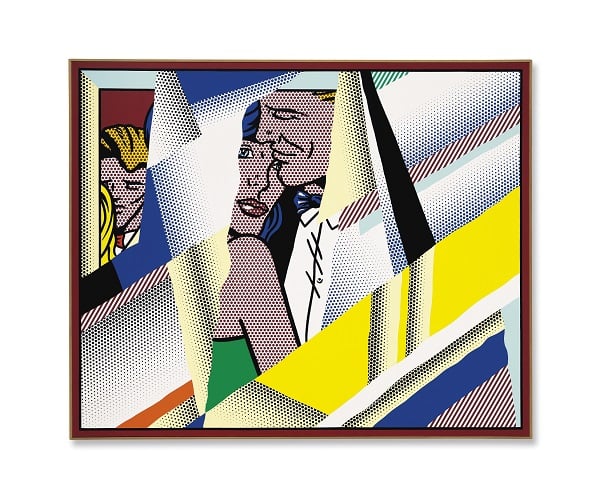
.Courtesy of Christie's.
The stars of the evening were Warhol's portraits of Elvis and Marlon Brando.

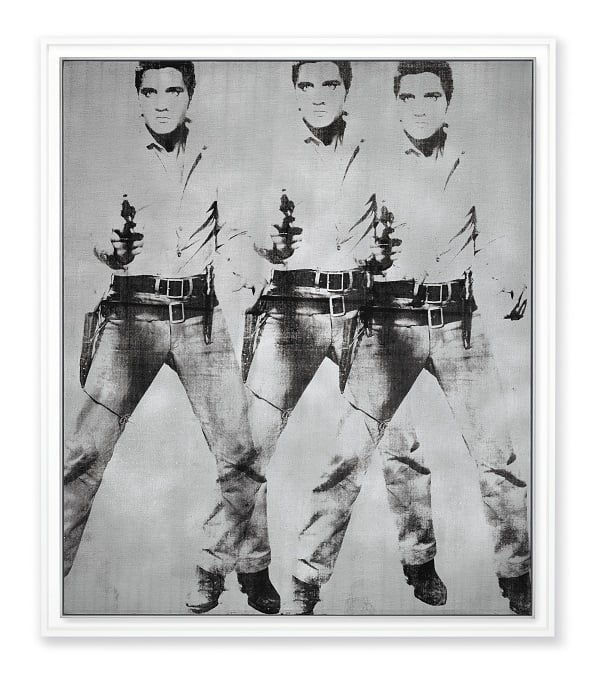
Andy Warhol’s “Triple Elvis (Ferus Type)” (1963) sold for $81.9 million (it was estimated to sell in the region of $70 million).
Courtesy of Christie’s.
Christie’s marathon sale of postwar and contemporary art this evening was held before a tightly packed salesroom in Rockefeller Center that crackled with energy and seemingly limitless demand for masterpieces of Pop art and Abstract Expressionism, as well as some of the most in-demand living artists today. One of the most telling details of the sale was the number of lots—20 in total—with a minimum estimate of $10 million.
In all, the sale pulled in a total of $852.9 million—way above the estimate, which was in the region of $600 million. A total of 15 artist records were set, including that of Cy Twombly, Martin Kippenberger, and Ed Ruscha. Of 80 lots offered (two were withdrawn), 75 (or 94 percent) were sold. By value the auction realized 97 percent.
As expected, the stars of the evening were Warhol’s silkscreen portraits of entertainment icons Elvis and Marlon Brando. Together, they accounted for $151.5 million of tonight’s total. Each was estimated to sell for around $70 million. In addition to packing a celebrity punch with these two entertainment icons—Elvis in a cowboy stance pointing a gun and Brando in a shot from the film The Wild One—the works had a sterling provenance and were being offered at auction for the first time.
Months prior to the sale, when the consignments were revealed, Christie’s head of postwar and contemporary art Brett Gorvy had said that he thought the paintings could potentially break the $100 million mark, and possibly even Warhol’s record (then, and still) of $104.5 million for Silver Car Crash (Double Disaster) set at Sotheby’s in November 2013.
Christie’s, clearly confident about these back-to-back offerings, filled small containers in the lobby with complimentary silver and gold rubber bracelets inscribed with its corporate logo and either the phrase “Warhol Elvis” of “Warhol Brando” that auction-goers could help themselves to.
Auctioneer Jussi Pylkkanen opened bidding on the Elvis portrait at a whopping $48 million and it was immediately chased up by numerous bidders before selling to a phone buyer, through a Christie’s specialist, for a hammer price of $73 million, or $81.9 million with premium.
The Brando portrait followed right after, opening at $40 million, and was pursued mostly by specialists Laura Paulson and Loïc Gouzer for their respective clients, going head-to-head in $1 million increments before Gouzer finally won it for his client on a hammer bid of $62 million. Including premium, the final price was $69.6 million.
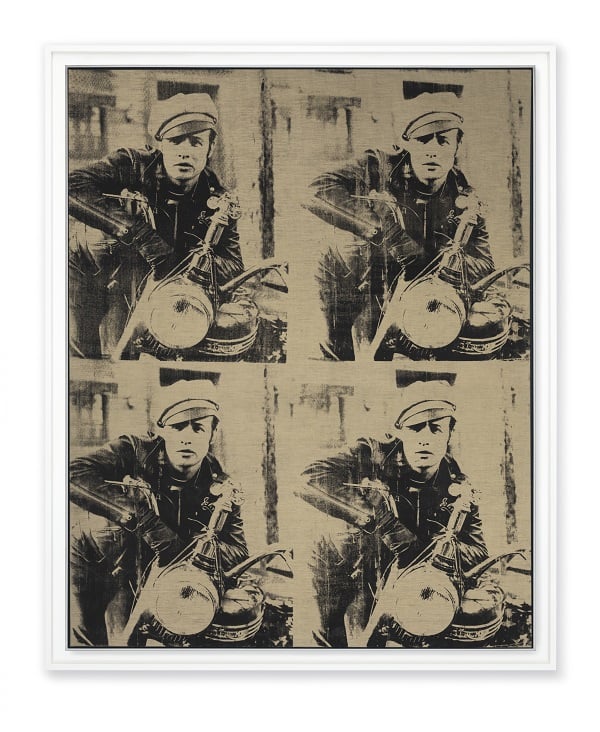
Andy Warhol’s Four Marlons (1966) sold for $69.6 million (estimate in the region of $70 million).
Courtesy of Christie’s.
Since the late 1970s, the works Triple Elvis (Ferus Type) (1963) and Four Marlons (1966) had been hanging in a casino in Aachen, Germany, one of a chain owned by WestSpiel, a German government–controlled company. Apparently dealers and auction experts have known about the works and have had their eyes on them for years, according to the report. They were bought from powerhouse Swiss dealer Thomas Amman in the late 1970s. The Elvis went for $85,000 and the Brando for $100,000.
Gorvy said he was counting on significant bidding from Asian buyers who have been active in the Warhol market for several years now, and also counting on “serious collectors in America.”
Among the artists who had records set tonight was Peter Doig, who has been a favorite name among wealthy collectors, and in recent years particularly of Russian oligarchs. His 1994 oil Pine House (Rooms for Rent), which was estimated to sell for around $15 million, went for $18 million. (To give a little context where pricing is concerned, the same painting was sold at Christie’s London in 2009, where it made $2.3 million—£1.4 million—on an estimate of $2.4–3.3 million.)
A quintessential Cy Twombly chalkboard painting, Untitled (1970), featuring the artist’s white looping scrawls on a slate gray background, set a new auction record for the artist when it was sold tonight for $69.6 million. Its estimate was $35–55 million.
Powerhouse dealer Larry Gagosian was an active and frequently successful bidder here tonight. Seated in the center of the salesroom, he bought works which included Ed Ruscha’s appropriately titled 1963 oil painting Smash for a record $30 million (hammered down at $27 million). He had to fight off competition from fellow dealers seated in the room, including Christophe van De Weghe and Andrew Fabricant of the Richard Gray gallery. Gagosian also won Martin Kippenberger’s Untitled (1988) a self-portrait painting that was estimated to sell for $15–20 million and went for $22.6 million (with a hammer price of $20 million). Gagosian was also a bidder (but did not win) on Jeff Koons’s sculpture Pink Panther (1988) and two works by Bruce Nauman that were sold by the Cy Twombly Foundation.

Roy Lichtenstein’s Reflections on the Prom (1990) sold for $21.4 million (estimate in the region of $15 million).
Courtesy of Christie’s.
Other top sellers included a work by Roy Lichtenstein. The first up, Reflections on the Prom (1990), an oil and Magna on canvas, sold for $21.4 million (its estimate was about $15 million). The work was last offered at Christie’s New York in May 2008 when it brought in $8.8 million, above its high estimate of $5 million. But Lichtenstein’s much earlier oil and graphite on canvas Keds (1961) failed to kick up any interest at all. It was estimated to sell in the region of $20 million, despite never having been at auction before, and was the first buy-in at an otherwise spectacularly strong sale.
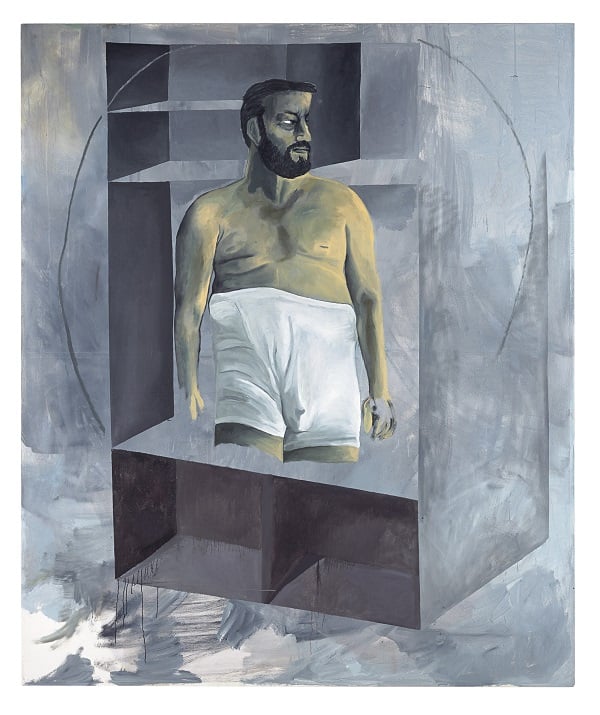
Martin Kippenberger’s Untitled (1988) sold for $22.6 million on an estimate of $15–20 million.
Courtesy of Christie’s.
Francis Bacon’s Seated Figure (1960) sold for $44.9 million ($40 million hammer) just above its low estimate of $40 million, and just met the minimum on a single bid from contemporary department head Brett Gorvy who was bidding for a client on the phone. Tonight’s consignor had shelled out $2.5 million (£1.5 million) when he or she bought it at Christie’s London in December 1996 (then it was estimated to sell for $2.4 million). The Bacon was the last hotly anticipated major lot before many people began to stream out of the packed auction room having witnessed auction history in the making.
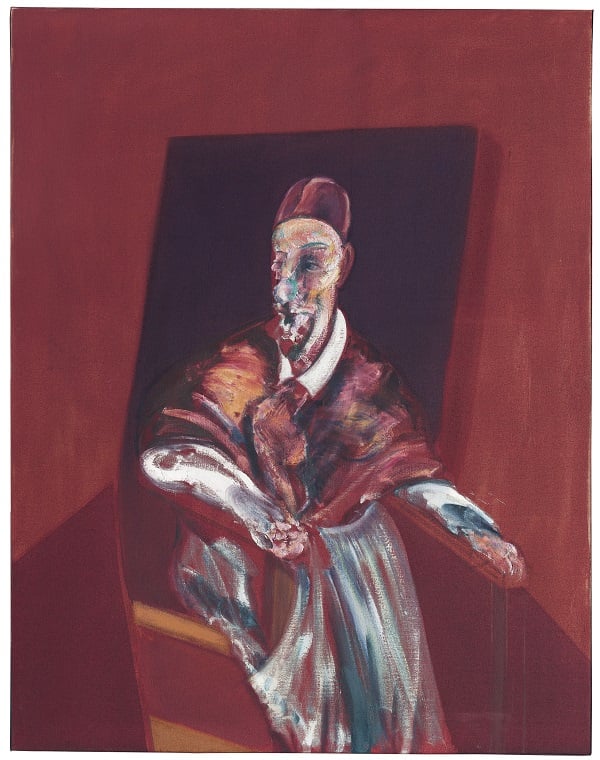
Francis Bacon, Seated Figure (1960) sold for just under $45 million on an estimate of $40,000,000–$60,000,000.
Courtesy of Christies.
Though it was an epic night for Warhol, prior to the sale, Pylkkanen announced that lot 55, Warhol’s Self-Portrait (1986), one of his “Fright Wigs,” with a weighty estimate of $25—35 million, had been withdrawn from the sale. Some auction-goers wondered if the consignor had been frightened off by the mediocre performance of a similar painting at Sotheby’s last night. The other withdrawn lot was the Peter Doig’s painting Briey (Interior) (1999), which had been estimated to sell for $5–7 million.
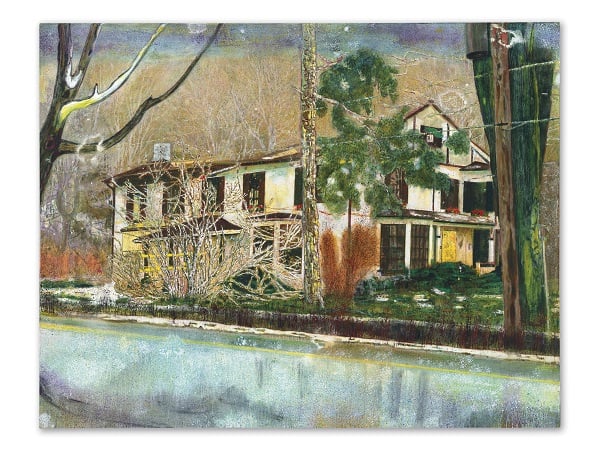
Peter Doig, Pine House (Rooms for Rent) (1994) sold for $18 million, a new artist record at auction (estimate in the region of $15 million).
Courtesy of Christie’s.